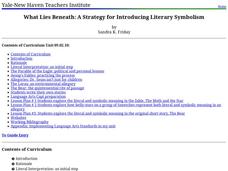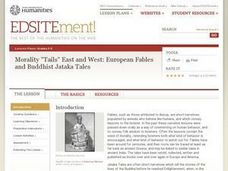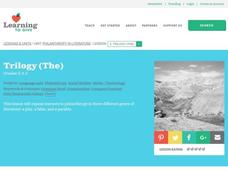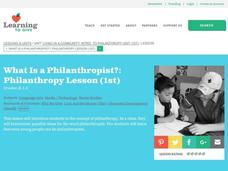Scholastic
Teaching with Aesop's Fables
Bring the applicable morals of Aesop's Fables to your classroom with a series of reading comprehension activities. With 12 different fables with activities and exercises, the packet focuses on the ways learners can apply the fables and...
Core Knowledge Foundation
Fables and Stories Tell It Again!™ Read-Aloud Anthology
A read-aloud anthology focuses on fables. Over three weeks, first graders listen to various stories and then participate in lessons that cover story elements, including plot, characters, setting, and personification and explore...
Curated OER
Learning Life Lessons through Fables
Explore a variety of fables to learn life's lessons through engaging stories. Add rigor to the learning process with activities that include matching a a fable to the story's moral, short answer exit slips, and a three-column graphic...
Core Knowledge Foundation
Nursery Rhymes and Fables Tell It Again!™ Read-Aloud Anthology
A 206-page kindergarten anthology offers various nursery rhymes and fables. Each lesson covers a different reading and examines a concept that best relates to the rhyme or fable. Lessons begin with an introduction to the reading, go into...
Federal Reserve Bank
Financial Fables: Shopping Wisely with Olivia Owl
Cover two subjects with one instructional activity! First, dive into English language arts; read an eBook, answer comprehension questions, and complete a cause and effect chart about the financial fable, Shopping Wisely with Olivia Owl....
Yale University
What Lies Beneath: A Strategy for Introducing Literary Symbolism
“It’s not about what it is, it’s about what it can become.” You’re never too old for Dr. Seuss and using The Sneetches and The Lorax is a great way to introduce readers to allegories, parables, and literary symbolism. The lessons...
Curated OER
Morality "Tails" East and West: European Fables and Buddhist Jataka Tales
Have your class explore Buddhist Jataka Tales to compare and contrast them to European fables. After defining fables, Jataka tales, and the elements of each, learners identify themes and patterns for both types of narratives and the...
Great Books Foundation
The Fox and the Stork
Young readers take part in a meaningful discussion following a reading of Aesop's fable "The Fox and the Stork." Five questions focus on the characters' actions and offering apologies.
Overcoming Obstacles
Cooperation and Teamwork
One of Aesop's fables begins with a activity about cooperation and teamwork. Scholars listen carefully, taking note of the moral of the story. The class discusses their findings and why working with others makes work easier. Learners...
Curated OER
And the Moral Is...
Students complete a unit using Aesop's fables to learn about morals and insert them into their everyday lives. In this moral values lesson, students complete four lessons using various Aesop's fables.
Curated OER
Theme vs. Topic
Students use Aesop's fables to examine theme and topic. For this theme and topic lesson, students read different fables and discussing as a class. After hearing more stories students work in pairs to determine the theme or topic.
Curated OER
Fables and Trickster Tales Around the World
Students analyze fables and trickster tales from various cultural traditions. In this fable analysis lesson plan, students identify the elements of fables and trickster stories. Students read Aesop's fables and Ananse spider stories....
Curated OER
Understanding and Writing Fables
Third graders review with the teacher the characteristics for a fable and what it is. They read one paragraph each from the story, "The Fox and the Stork" aloud. They then answer comprehension questions aloud. Next, they listen to four...
Curated OER
Fabulous, Fractured Fables
Elementary schoolers develop an awareness of the literary form known as the fable. They explore how authors write fables to pass along moral lessons. After reading and discussing many famous fables embedded in the plan, learners attempt...
August House
The Hidden Feast
What is a proverb? This is the leading question of this resource. First, explore proverbs and their meanings. Then, read aloud The Hidden Feast: A Folktale from the American South by Martha Hamilton and Mitch Weiss and partake in a grand...
Curated OER
Acting Like a Bunch of Animals: Fables and Human
The video "The Tales of Aesop" traces for viewers the history of fables and identifies their characteristics. The class then goes to the web site "The Fisherman and the Little Fish" where they examine the classic and a modern version of...
Curated OER
Deciding Theme
Read aloud to your class the fable "The Lion and the Mouse" as you explore characters' choices and the effects they have on a story. Apply what is discussed to finding a theme of the chapter "Not Giving Up" from The Wizard of Oz.
Overcoming Obstacles
Being Responsible
Responsible-decision making is the focus of the social-emotional learning lessons. After reading, The Ant and the Grasshopper: An Aesop Fable, scholars come up with six steps to take responsibility for their actions and then practice the...
Curated OER
Latino Folklore and Culture: Stories of Family, Traditions of Pride
Learners define the terms fable and folktale. They write a fable to illustrate a Latino proverb. Students are explained that a folktale is a story passed down through the oral tradition of a particular culture. A fable is a type of...
Curated OER
What is a Philanthropist?
What does a philanthropist do? Help your class explore philanthropy using character development and literacy ideas. Learners will define and give examples of philanthropy, listen to The Lion and the Mouse, discuss how the characters help...
Curated OER
Philanthropy in Literature
Students research philanthropy in three genres: a play, a fable, and a parable. Students read an Aesop fable and answer questions in groups. Students complete steps in two worksheets from 'The Good San Franciscan' and 'Someone Should.'...
Curated OER
Small Actions with Big Results
Students explore philanthropy in literature. In this literature lesson, students read text from three different genres that all have a moral. Students compare and contrast these pieces of literature, focusing on the character traits that...
Curated OER
What is a Philanthropist?
Students discuss the conceptual framework of philanthropy. In this introduction to philanthropy lesson, students define the term philanthropist and read the story Lion and the Mouse. Students discuss the concepts of philanthropy...
Curated OER
Lesson Plan: Final Phoneme ll, ff, ss
Students apply word level skills through shared and guided reading.
Other popular searches
- Aesop's Fables 3rd Grade
- Aesop's Fables Videos
- Aesop's Fables Activities
- Aesop's Fables Worksheets
- Aesop's Fables Unit
- Aesops Fables Unit
- Aesops Fables Powerpoint
- Aesop's Fables Lesson Plans
- Aesop's Fables Plays
- Aesops Fables Comparison
- Aesop's Fables Literacy
- Aesops Fables Literacy

























